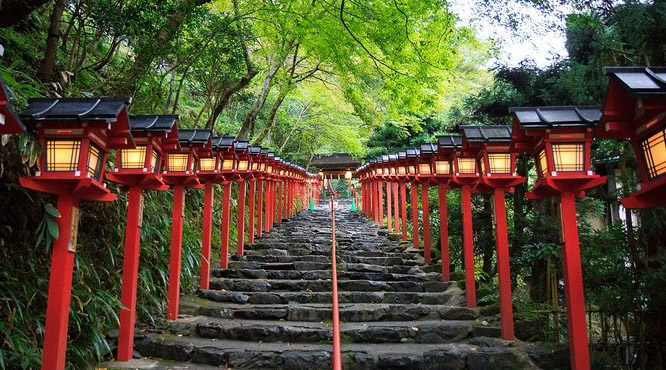Kurama Introduction
Kurama is renowned for its ancient temple, Kurama-dera, perched on a steep mountainside. The journey from the base to the main temple buildings takes 30-45 minutes on foot, with a cable car available for part of the ascent. The lush forests surrounding the temple create a mysterious and serene atmosphere, providing visitors with fresh air and stunning views.
Beyond Kurama-dera, the town boasts the famous Yuki Shrine, known for its annual Fire Festival. The Kurama Onsen, while temporarily closed due to the pandemic, has long been one of the most accessible hot springs from Kyoto.
Join us as we explore this captivating town that seamlessly combines nature, culture, and leisure!
Highlights
- Kurama-dera: A thousand-year-old temple on a steep mountainside
- Yuki Shrine: Famous for its Fire Festival
- Kurama Onsen: An easily accessible hot spring retreat
- Hiking trail: A forest path from Kurama to Kibune
- Cable car: A convenient way to ascend the mountain
Rich History
Kurama-dera was founded in 770 CE by Ganjin, a disciple of the monk who established many of Nara’s great temples. Initially belonging to the Shingon sect of Buddhism, it later transferred to the Tendai sect during the Heian period. The name “Kurama” is said to derive from the mountain’s resemblance to a horse’s saddle.
Mount Kurama has long been considered a sacred site in both Shinto and Buddhist traditions. It’s believed to be the dwelling place of tengu, supernatural beings in Japanese folklore with extraordinary powers.
Beyond its religious and martial traditions, Kurama is known for its unique natural energy. Many believe Mount Kurama contains powerful earth energy, attracting visitors seeking spiritual inspiration and natural healing.
Main Attractions
Kurama-dera
Kurama-dera is the town’s central attraction. The climb from the base to the main hall takes 30-45 minutes. A cable car (200 yen one-way) is available to reach the halfway point, saving energy and offering scenic views.
The main temple buildings are situated on a terrace on the mountainside, overlooking a lush, wooded valley. The main hall enshrines Mao-son, a deity representing power and wisdom in Buddhism. The temple houses numerous precious Buddhist artifacts, including national treasure-level Buddha statues and ancient scrolls.
Yuki Shrine
Located along the path to Kurama-dera, Yuki Shrine is famous for its Fire Festival (Kurama Hi Matsuri) held annually on October 22. During the festival, local residents parade with large torches, creating a spectacular scene. This traditional event, with a history spanning over a thousand years, is believed to ward off evil and pray for a bountiful harvest.
Kurama Onsen
Although currently closed due to the pandemic, Kurama Onsen has long been one of Kyoto’s most popular hot springs. Located just a 10-minute walk from the train station, it offers both indoor and outdoor baths. The outdoor bath is surrounded by lush forest, making visitors feel embraced by nature. Once reopened, it will undoubtedly be an excellent place for relaxation.
Kurama to Kibune Hiking Trail
Behind the main hall of Kurama-dera, a hiking trail leads to the neighboring valley of Kibune. The hike takes about an hour and offers beautiful forest scenery. This trail is especially stunning in spring and autumn, with cherry blossoms and new greenery in spring, and colorful foliage in autumn. The path passes by several shrines and temples, adding cultural interest to the nature walk.
Best Time to Visit
Kurama is beautiful year-round, but these seasons are especially recommended:
- Spring (March-May): Cherry blossoms bloom and the forest comes to life
- Autumn (October-November): Vibrant fall colors and the Fire Festival
- Winter (December-February): Scenic snowscapes and the allure of hot springs
Getting There
Reaching Kurama from central Kyoto is convenient:
- Take the Eizan Railway Kurama Line from Demachi-Yanagi Station to Kurama Station. The journey takes 30 minutes and costs 470 yen.
- Trains depart every 15-20 minutes.
- From Kyoto Station, take the JR Nara Line to Tofukuji Station (2 minutes, 150 yen), then transfer to the Keihan Main Line to Demachi-Yanagi Station (10 minutes, 280 yen).
Hours and Admission
- Open: 9:00 to 16:15
- Open year-round (Treasure house closed on Tuesdays and from mid-December to February)
- Admission: 500 yen
Visitor Tips
- Wear comfortable shoes suitable for hiking
- Bring water and snacks as food options are limited on the mountain
- Check the weather forecast as paths can be slippery when wet
- Respect local customs and refrain from taking photos where prohibited
Official Websites
- Kurama-dera: http://www.kuramadera.or.jp (Japanese only)
- Kurama Onsen: http://www.kurama-onsen.co.jp (Japanese only)
Conclusion
Kurama is an unmissable hidden gem in Kyoto. Whether you’re interested in visiting an ancient temple, experiencing traditional hot springs, or enjoying a forest hike, Kurama has something to offer. Come and experience the tranquility of the mountains and let your body and soul be refreshed by the harmony of history and nature!
In our bustling modern society, Kurama offers a rare opportunity to escape the urban noise and immerse ourselves in nature. Whether it’s the cherry blossoms of spring, the lush greenery of summer, the red leaves of autumn, or the snow scenes of winter, Kurama has its unique charm in every season.
We sincerely invite you to come to Kurama and experience its natural beauty and cultural depth firsthand. We believe this journey will not only leave you with beautiful memories but also bring deep relaxation and inspiration to your mind and body. Let’s find inner peace and strength amidst the mountains and waters of Kurama!
Cover image author: lovetogo.sharon@gmail.com
